The only constant in SEO is change.
Take the classic case:
Your page ranks top three, netting you 10x the traffic and leads and customers than competitors from positions six to ten.
So you publish publish publish to build on past success. But two things happen:
- Your new content takes months (if not years) to rank top three, while…
- Your stuff ranking top three now slowly loses positions to new entrants.
Any SEO professional worth their salt has seen this happen.
Past content that used to perform so well slowly erodes over time.
It no longer lines up with search intent. New stuff has supplanted it. As the world evolves, so should our content.
No need to despair, though.
This is actually a pretty easy problem to fix. All you need is this simple three-step content optimization blueprint that we’ve used to resurrect prior winners from the dead consistently.
Why the best SEO quick wins come from optimizing and republishing content
We helped a large publisher in the finance space increase its traffic per page by an average of 121.9% in about a year.
Around 30 different URLs were flagged as “optimization opportunities” – nerdy shorthand for “stuff that used to rank well but now kinda sucks.”
These are easy to find once you know where to look. And fairly easy to jumpstart, too.
For example, one article was republished on Jan. 1, 2021, and instantly doubled in traffic.
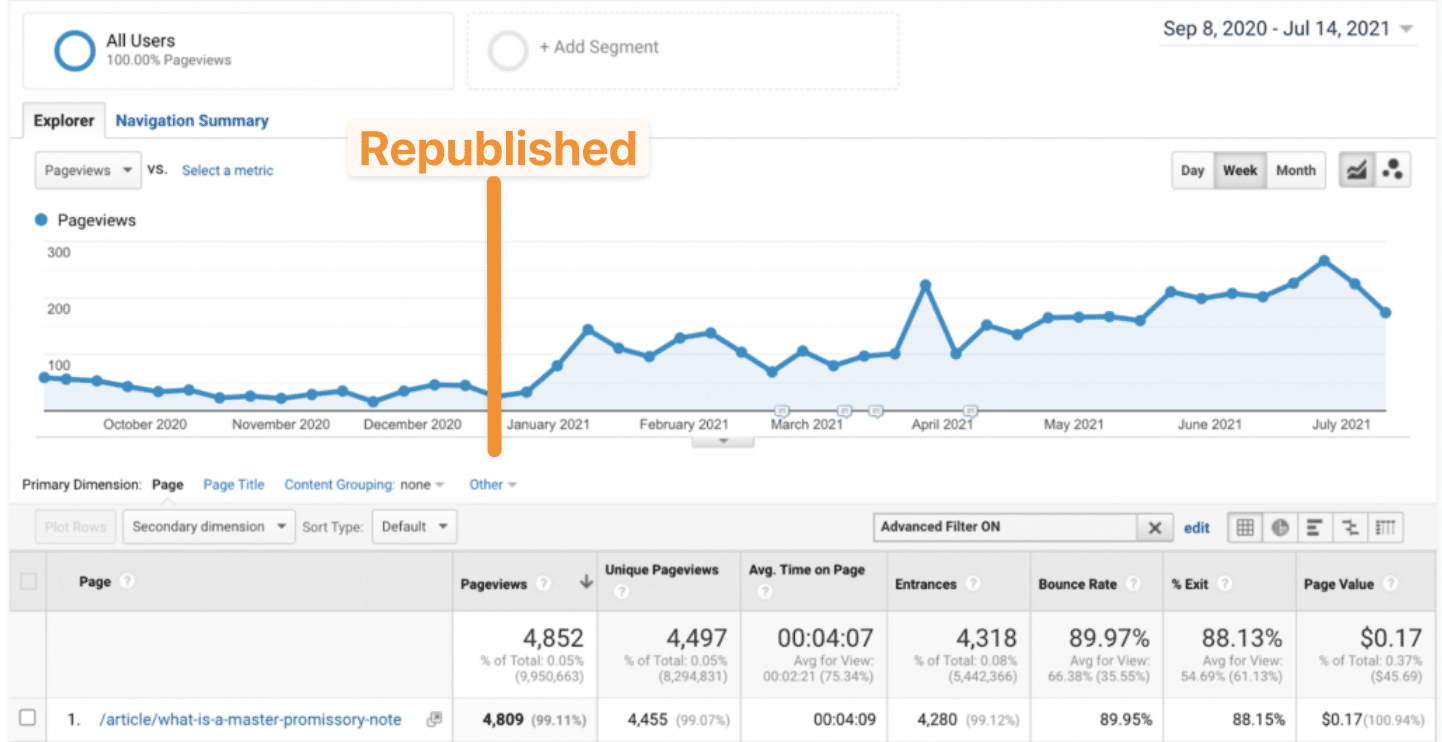
And this one, republished just a few days before on Dec. 15, 2020, resulted in a new steady stream of visits for the remainder of the next year.
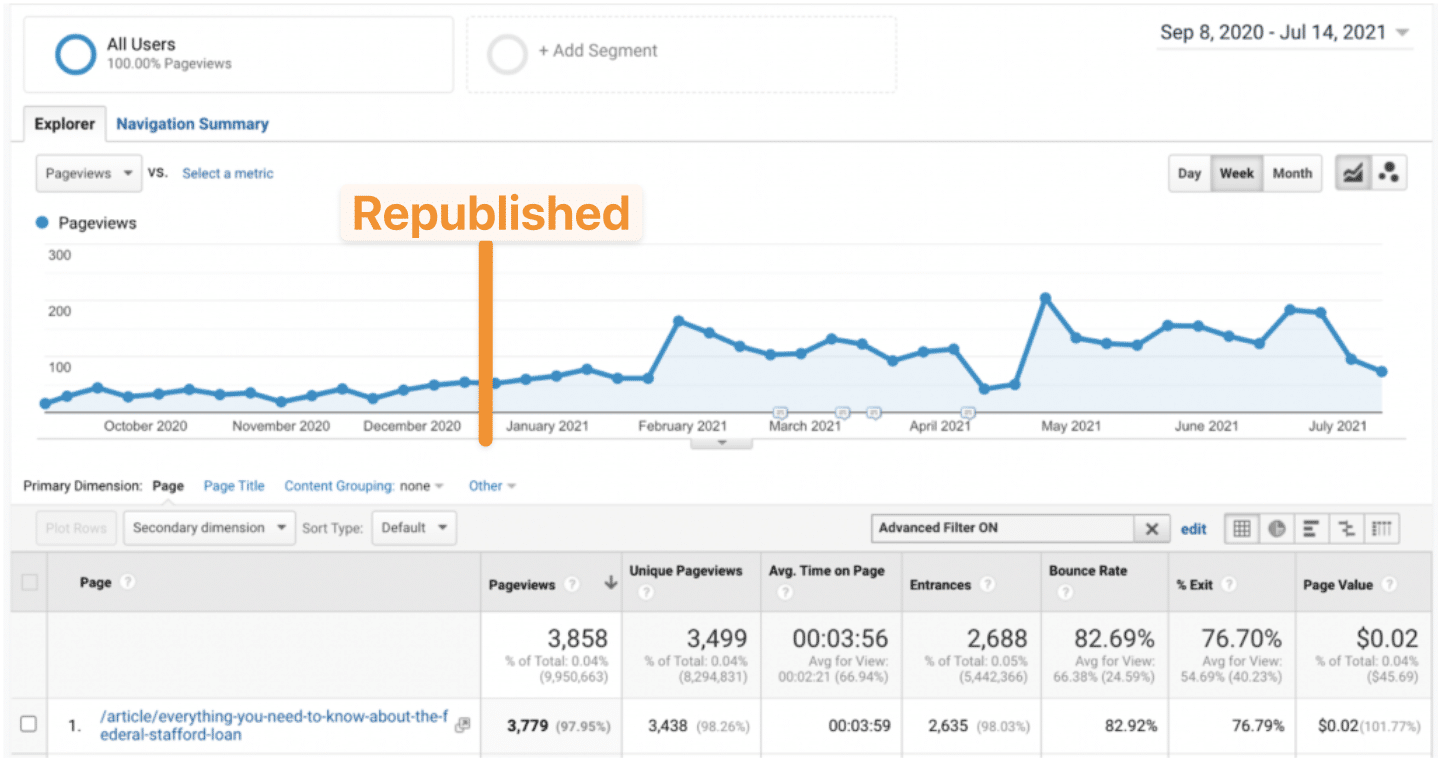
And another one.
This time, republished days later on Jan. 19, 2021, took off like Elon’s rockets.
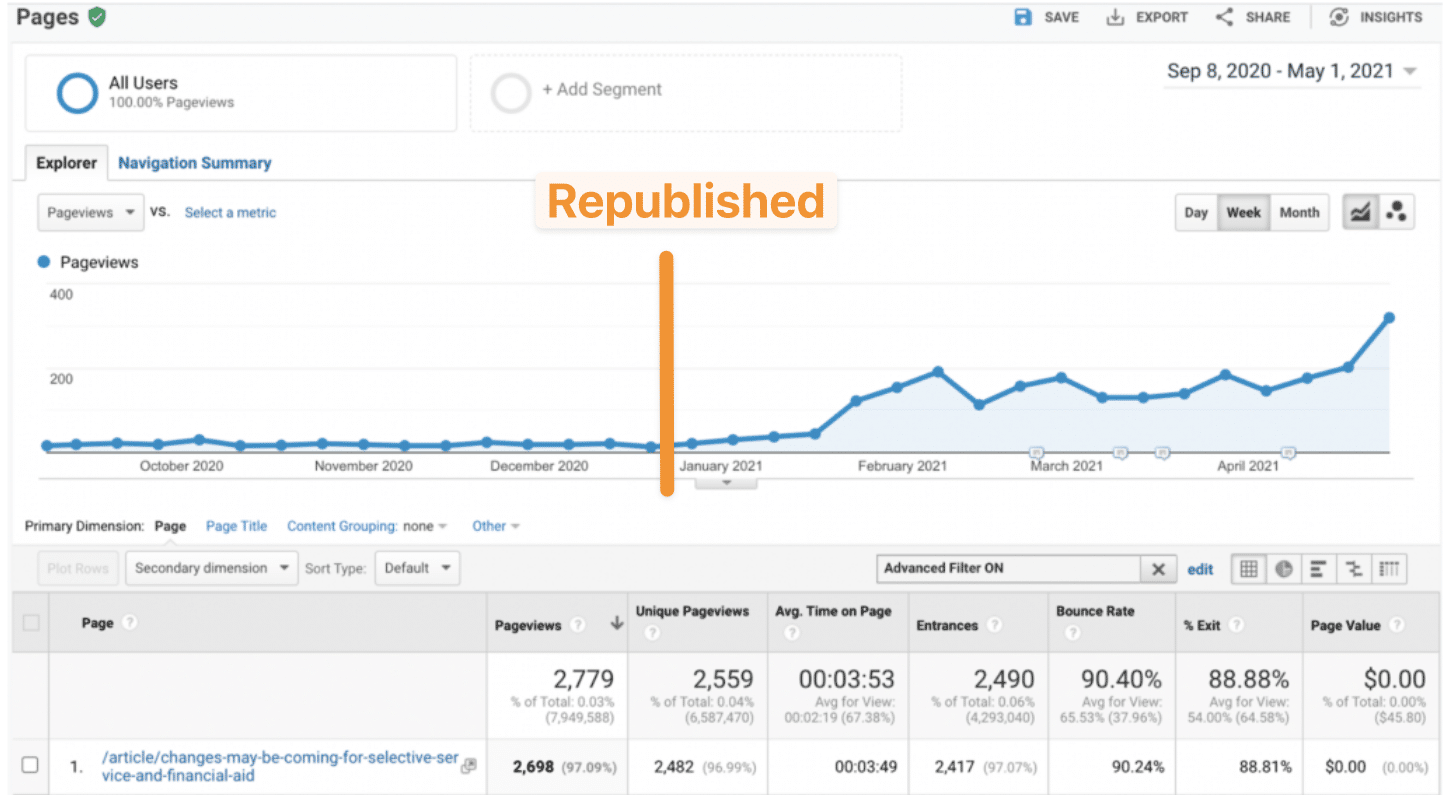
Convinced yet?
Keep in mind this is a large site, originally founded waaaaaaaay back in 1999. So it’s had some success, a high DR, and topical authority for years. It’s got a head start in that sense.
But that doesn’t change the main point:
- Want long-term (24+ months) growth? Publish new content.
- Want short-term (< 6 months) growth? Republish existing content.
Now, let’s cut the chit-chat and run through the exact steps you can use to replicate these results.
Step 1: Identify which existing URLs are ripe for republishing
You know what they say: If it ain’t broke, don’t fix it.
Are your URLs in the top 3-5 positions already? Refresh lightly but don’t rock the boat.
But, the stuff below the top five? Now we’re talkin’.
This is the stuff that’s got some decent traction or maybe recently slipped. It’s seeing some traffic, which is important. However, not enough traffic ‘cause it’s stuck in no man’s land outside ~80% of SERP clicks.
So pull up your favorite SEO tool, and let’s run a quick list.
First, pull up all the organic keywords that your site is currently ranking for, like so:
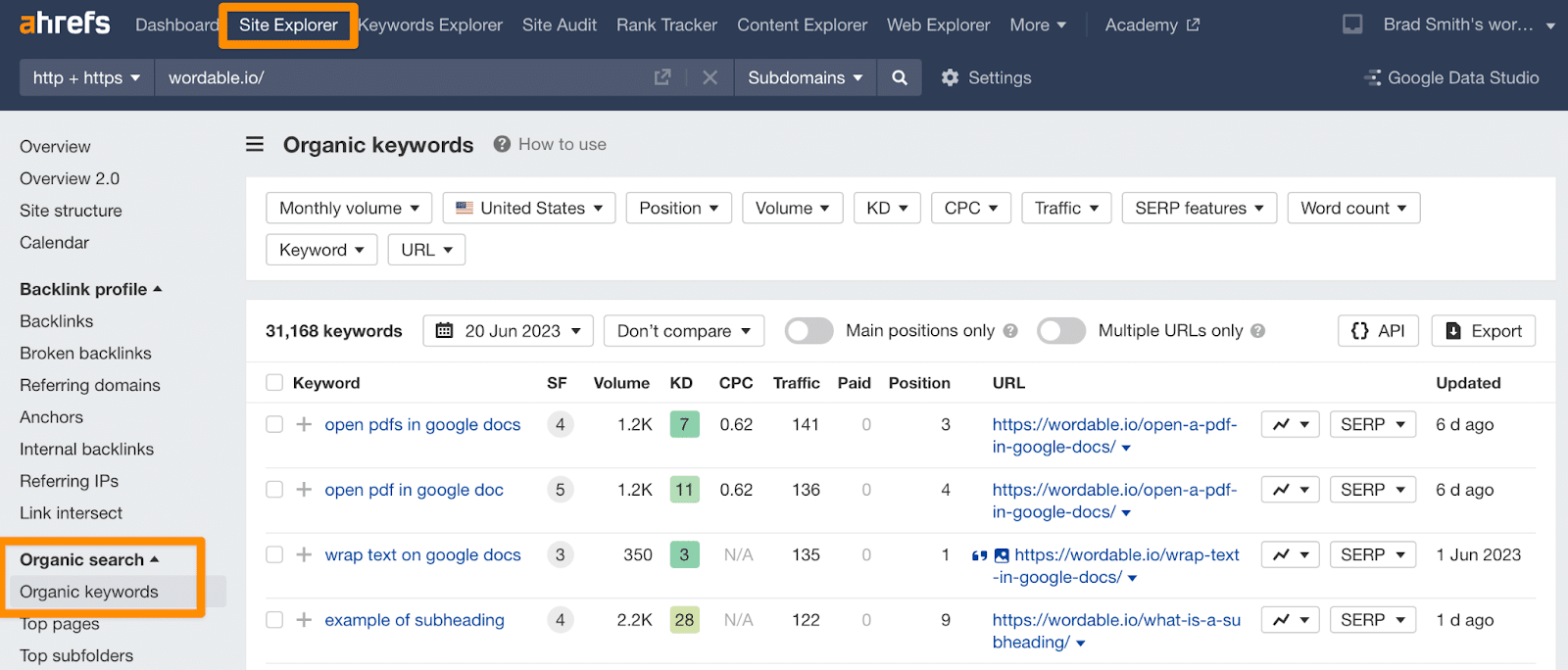
Next, define your parameters. This could be positions 8 to 20 or 5 to 10. Doesn’t really matter. The point is the point: stuff that’s seeing a little traffic but not nearly enough as it should.
I also like setting a floor for volume to make sure we’re not worrying about tiny keywords or pages while at the same time setting a difficulty cap to make sure we’re focusing on low-hanging fruit (and not biting off more than we can chew).
The latter point is especially important. If you pick super difficult keywords, optimizing and republishing content on its own might not be good enough. You’ll probably still need high-quality links and more to crack into the top five sooner rather than later.
These exact floor or cap numbers are somewhat arbitrary based on your space’s competitiveness and your site’s strength. Larger/older sites should go higher on both, while smaller/newer sites should go lower.
But let’s go with the example of “100” for minimum volume and “30” for max keyword difficulty (KD).
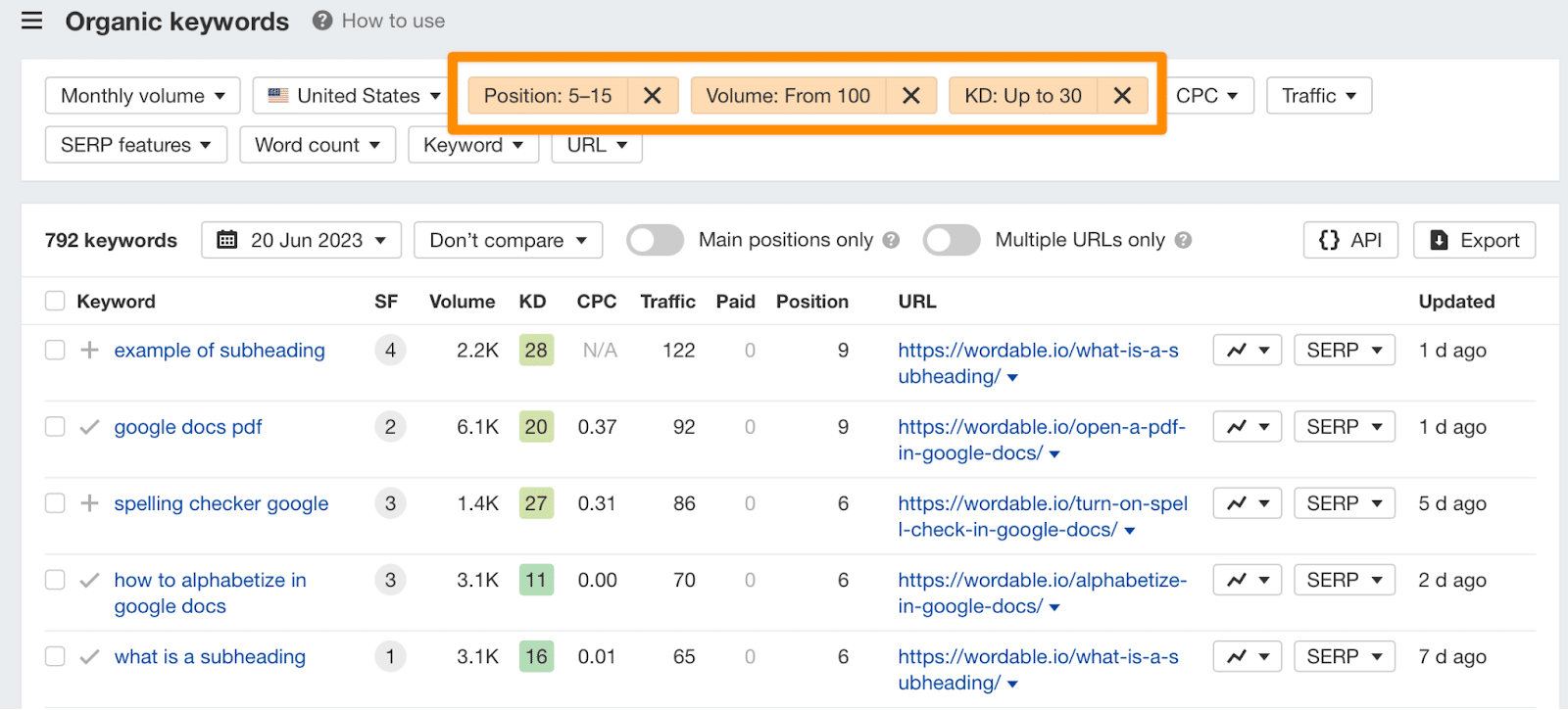
Now we’re getting someplace.
About ~90 seconds worth of work just generated a list of your low-hanging SEO fruit.
So let’s now separate the wheat from the chaff. (I had to look that one up, too.)
We want to identify good republishing candidates from bad ones. We’re going to measure twice and cut once in the next section.
Step 2: Prioritize the 20% of your existing content will provide an 80% lift ASAP
Good news and bad news.
That simple previous step might generate hundreds (or more) URLs on larger sites. So you’ll need to do a little manual work, ignoring or cutting or disregarding the irrelevant posts or pages.
Generally speaking, it makes sense to prioritize based on:
- Previous results (obviously always prioritize your top lead or sale drivers, first).
- Commercial intent (so prioritize your BOFU > over your MOFU > and then over your TOFU).
- Top traffic getters (think: TOFU on steroids).
- Top traffic drops (compare this period, like month or quarter, vs. the previous year).
Your actual mileage might vary, because a publisher should prioritize different posts/page types from a B2B SaaS brand vs. B2C ecomm vs. local service business.
What you’re looking for at this stage is a simple Pareto Principle. What are the 20% of URLs that will give you the fastest 80% return?
For instance, drilling into this article on subheadings quickly shows us that there are many more keyword variations we’re picking up.
Lots actually! With great volumes and low-is KDs! So let’s flag this one as a priority now, too!
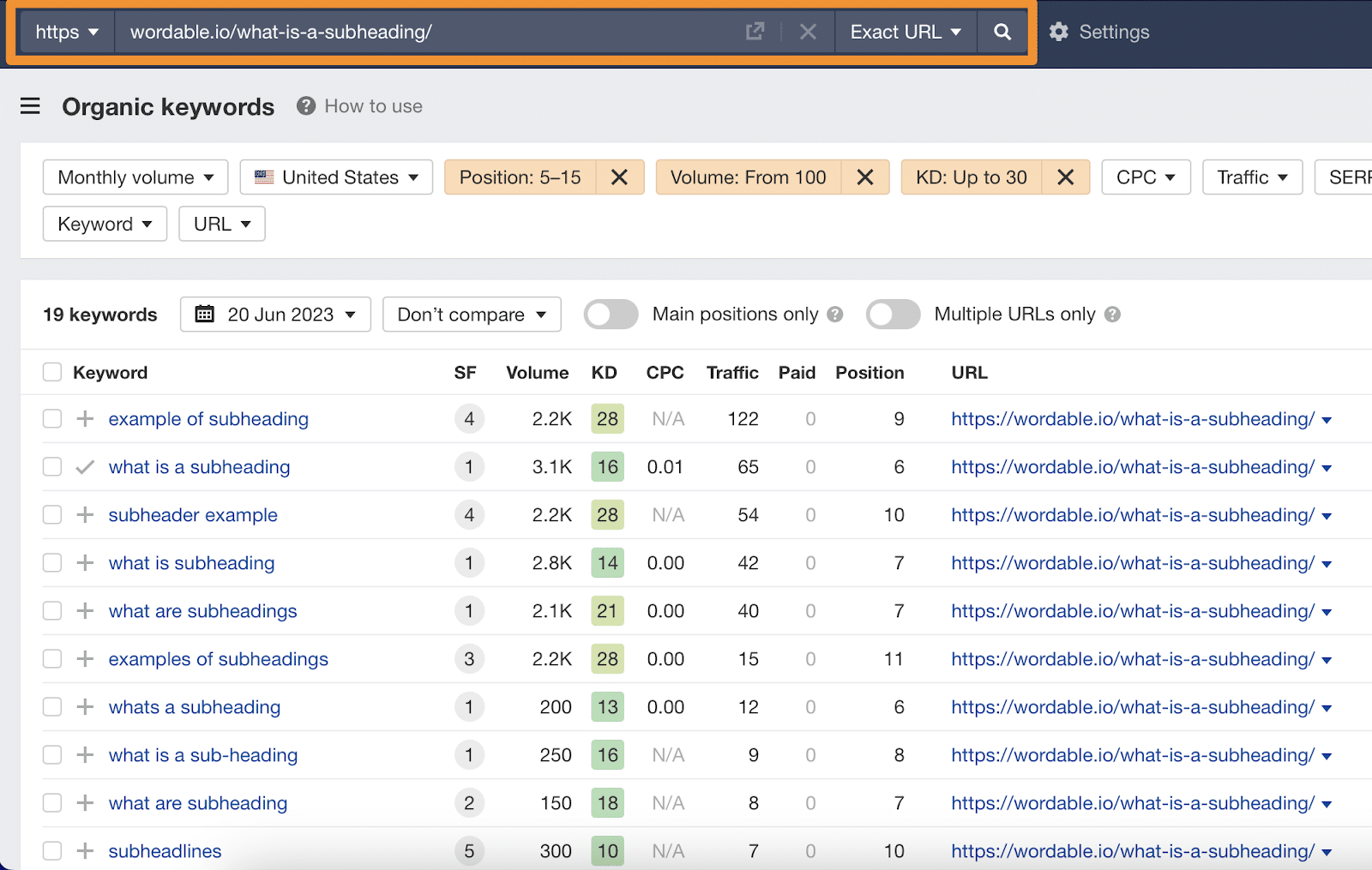
Step 3: Determine what, specifically, about the content needs updating
It’s important to keep in mind that we’re not just updating content for updating’s sake here.
This is not about simply refreshing the “Updated on…” date string in WordPress to fool the SEO gods and calling it a day.
Instead, this step is about figuring out how we’re actually going to make the content much better. We want it to rank higher and move the needle for business KPIs.
So once you have a few URLs to prioritize, it’s time to do a little heavy lifting.
Unfortunately, content tools still suck at SEO, while SEO tools still suck at content. I’m including AI in here, too, which is still years away from making a true dent.
That means you gotta roll up your sleeves a little bit. Start by actually clicking on each URL and reading through it. Then, pull up some of the SERPs it’s currently ranking for, look at the results, and actually read through those, too.
Now, I know what you’re thinking.
“Wait wait wait. Nobody said anything about using their brains and experience here. No AI fancy prompts or anything? Gasp!”
This is super easy, though.
Here’s what you’re looking for:
- How is your content organized, relative to what’s currently performing best on each SERP?
- Is there a search intent mismatch, say you’re trying to rank a landing page against many informational blog posts?
- Or is there overlapping search intent across multiple queries?
- Is your content structured like what’s performing best already?
- Are you experiencing any keyword cannibalization, where the wrong page URLs are currently ranking for the wrong queries?
- Are there any gaping holes in your topic coverage?
Let’s walk through how to do this last example, first.
Some specialized content optimization software here helps cut down the workload. Enter your MarketMuse’s, Clearscope’s Frase’s, et al.
Pull up the article in question, drop in the query you’re analyzing, and let them automatically scan the top-performing pages for you.
The output in Frase, for instance, will look something like this initially. Start with obvious areas like word counts, headers, and number of images, which can quickly give you a simple gauge of whether your content structure meets or exceeds the average SERP benchmark.
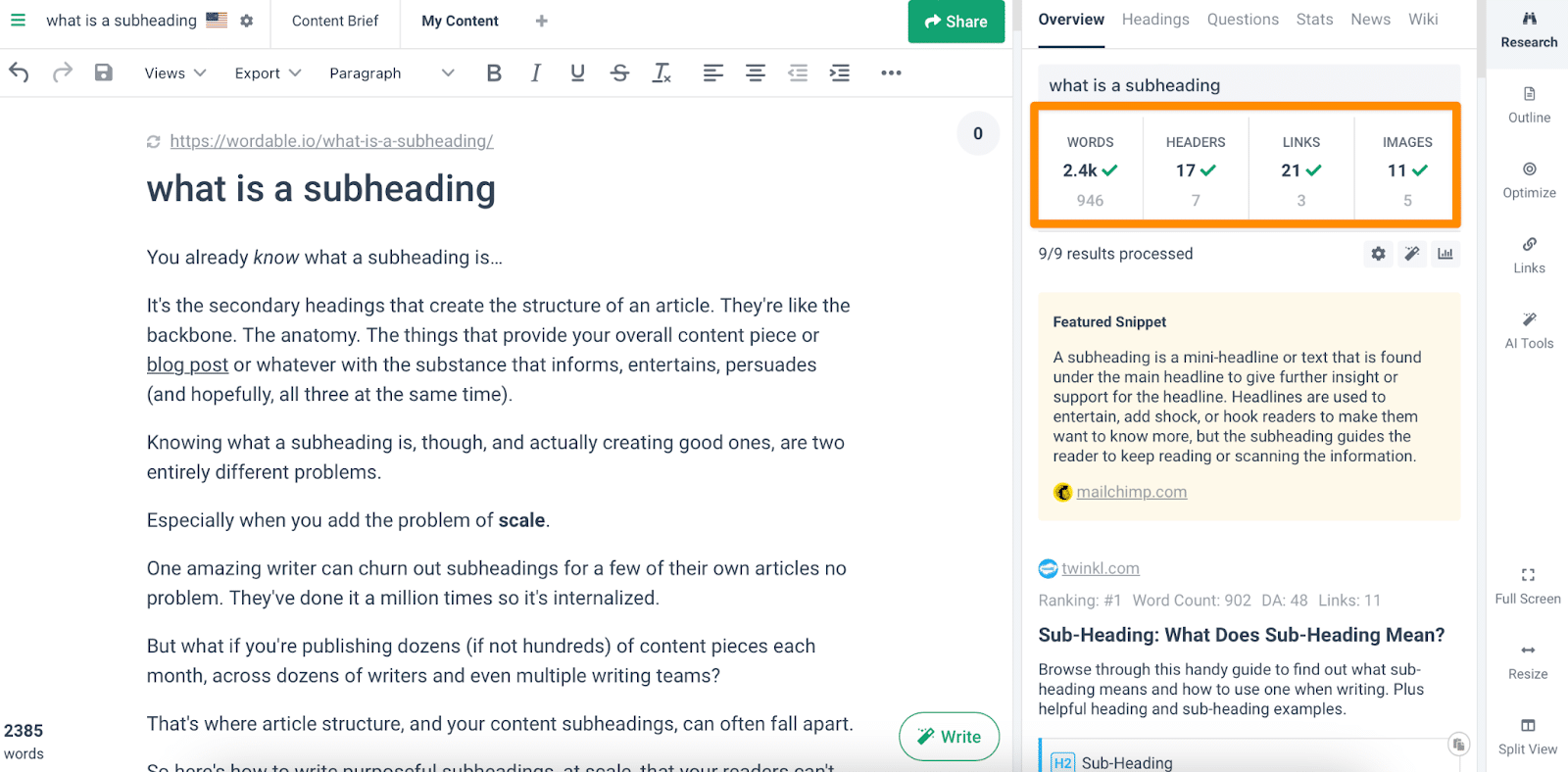
Next, look for semantic keyword coverage. Essentially, when people search for X, what are the tangentially related Y and Z they also want to read about?
Again, everything is relative here. So you shouldn’t be focusing so much on a “100%” score per se. This isn’t high school. Instead, you want to comfortable meet or exceed the competition at a bare minimum.
These specialized tools will help you easily compare semantic or related topic coverage against the competition, too, so you can quickly identify where you’re doing well…

...but more importantly, where you have gaps!
In the example above, notice “mini headlines” is missing across the board. Perfect. Now we know what to add or update to our existing content.
Obviously, this is a very simple, straightforward example. But the process is the same.
- What, specifically, in the content needs updating? (Maybe out-of-date information, no longer relevant, etc.)
- Where are you doing well – both structurally and content-wise – and can build upon?
- Where are you not doing well, relative to the competition? What needs improvement?
- Where are the remaining gaps or holes that you can potentially jump in front of the competition and outflank them before their stuff goes out of date, too?
The last one is key to future-proofing as much of your work as possible.
For example, we noticed that adding a video to one of these optimized articles dropped the bounce rate -11.94% almost overnight.

This last point is to hammer home that you're not just republishing content to bring it to par with your competitors.
It’s to surge ahead of them, throw down a competitive moat around yourself, and solidify your upcoming ranking gains for as long as possible.
Optimizing your content for the long term
Publishing brand-new content is what grows your site, traffic, and overall SEO presence for the long term.
But that’s the key word here: long term.
Anything you publish this year probably won’t move the needle until next year at the earliest.
Unless, of course, you’re upgrading and improving your existing content.
It’s almost always the single-highest leverage activity to generate short-term SEO results. The good news is that it’s pretty easy, too.
- Pull up all your existing content that’s doing pretty well but could be doing better (position five or lower)
- 80/20 them based on prior results, commercial intent, top traffic potential, or top traffic drops to provide the biggest lift in the shortest amount of time
- Ruthlessly compare your content to the competition’s to figure out how to not just match them but overtake and exceed them for the long haul
These steps, on top of good content planning and production processes, allow you to out-publish, outflank, and outrank competitors before they even realize what’s happened.
The post Steal this 3-step content optimization blueprint that drove a 121.9% traffic increase in one year appeared first on Search Engine Land.
source https://searchengineland.com/content-optimization-blueprint-traffic-increase-428647


0 Comments